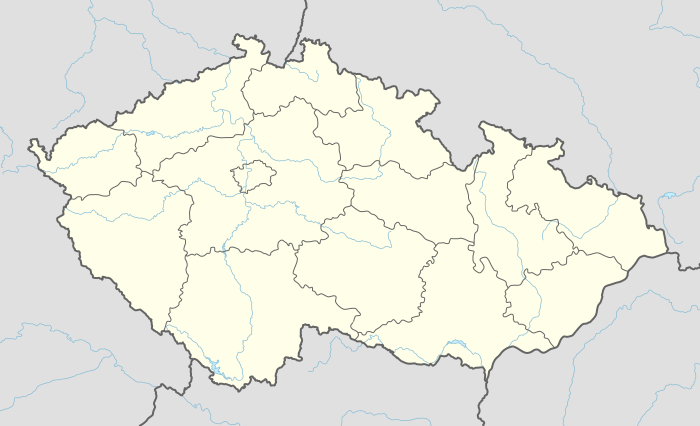Luže (Chrudim District)
Luže is a town in the Pardubice Region of the Czech Republic. It has approximately 2,600 inhabitants.
Luže | |
|---|---|
Town | |
 Pilgrimage Church of the Virgin Mary | |
 Flag  Coat of arms | |
 Luže Location in the Czech Republic | |
| Coordinates: 49°53′N 16°1′E | |
| Country | Czech Republic |
| Region | Pardubice |
| District | Chrudim |
| First mentioned | 1349 |
| Government | |
| • Mayor | Veronika Pešinová |
| Area | |
| • Total | 30.7 km2 (11.9 sq mi) |
| Elevation | 309 m (1,014 ft) |
| Population (2020)[1] | |
| • Total | 2,594 |
| • Density | 84/km2 (220/sq mi) |
| Time zone | UTC+1 (CET) |
| • Summer (DST) | UTC+2 (CEST) |
| Postal code | 538 54 |
| Website | www.luze.cz |
Districts
The districts of Luže are Bělá, Brdo, Dobrkov, Doly, Domanice, Košumberk, Luže, Rabouň, Radim, Srbce, Voletice and Zdislav.
History
Luže is located on the right bank of the river Novohradka. It lies between the woody hills of the Bohemian-Moravian Highlands and the plentiful Elbe lowlands. Luže was formed in 1250 when Kamenicza joined with the newly formed town of Luza. The history of the town is closely linked with the Košumberk castle. At the end of the Middle Ages, Luže was part of the manor of lords of Chlum and Košumberk, later Slavatas from Chlum and Košumberk. After the establishment of Czechoslovakia, Luže became a spa town. The Hamza sanatorium in Luže was founded in 1901 by professor František Hamza, M.D. It was the first sanatorium in Central Europe for children suffering from tuberculosis. In 1962 the treatment of tuberculosis patients stopped and Luže focused upon the rehabilitation of patients with mobility impairments. The present-day town Luže attracts tourists to its many monuments and beautiful nature in peaceful countryside.
Sights
Košumberk Castle
Košumberk Castle (Czech: Hrad Košumberk) was established by the noble family Slavata of Chlum. In the 17th century, the local branch of the family died out. The manor was inherited by the wife of Slavata, the Countess Hieserle. In 1690, the property was donated to the Jesuits. They managed the castle until the abolition of the Jesuit friary. The last owner of this estate was a Bavarian family of Thurn und Taxis, who owned the estate until the establishment of an independent republic. In 1922 "Družstvo na záchranu hradu Košumberka" was the team that retrieved Košumberk. Nowadays Košumberk is the property of the town of Luže. There is an historical exhibition of the castle and town.
Pilgrimage Church of the Virgin Mary on Chlumek
The Pilgrimage Church of the Virgin Mary on Chlumek (Czech: Poutní kostel Panny Marie na Chlumku) was founded by Mary Maximilian Countess of Žďár (Marie Maxmiliána hraběnka ze Žďáru). She built the church at her own expense. On 8 May 1668 Bishop Matouš Ferdinand Sobek dedicated the foundation stone, and on 9 August 1669 an expensive Baroque church was consecrated to the Virgin Mary. The church complex has a typical rectangular floor plan. The main aisle is demarcated by a balustrade interspersed by four larger and four smaller chapels. The building's construction and the architectural motifs are very precise. A unique set of artistic decorations adorns the building as well. Created around 1700, some of the works it contains are undoubtedly of gallery quality.
St. Bartholomew's Church
Originally a Gothic Church of St. Bartholomew first mentioned in historical records in 1381, St. Bartholomew's Church has been renovated several times. Part of the aisle has maintained the Gothic style. Within the church are some tombstones such as the tombstone of Diviš Slavata from Chlum and Košumberk.
The Synagogue and Jewish cemetery
On the South East side of town lies a district which was inhabited by a Jewish community. Since the late 18th century, the city had a Rabbi. Dwellers (309 persons in 1920) were almost exterminated during the Second World War. The Synagogue building from the 18th century has been renewed. A large Jewish cemetery about 1 km north of Luže has graves dating back to the 17th century.
Other sights
- Baroque house No.87
- Plague Column in the Koukal square
- Statue of St. Florian (1777)
- St. Jan Nepomuk Chapel (1726)
- Tree Linduše under Košumberk (protected natural monument)
- Paletínská Chapel
- Huge mounds of an incomplete Celtic settlement
- Protected nature sanctuary Poklona with rare flora
- Arboretum in the Hamza sanatorium area
Notable residents
See also
References
- "Population of municipalities of the Czech Republic". Czech Statistical Office. 1 January 2020.
External links
- Municipality website (in English)
- Municipality website (in Czech)
- Hamza Hospital (in Czech)